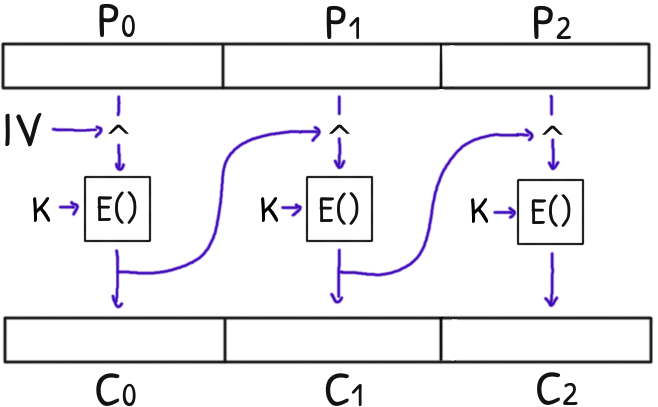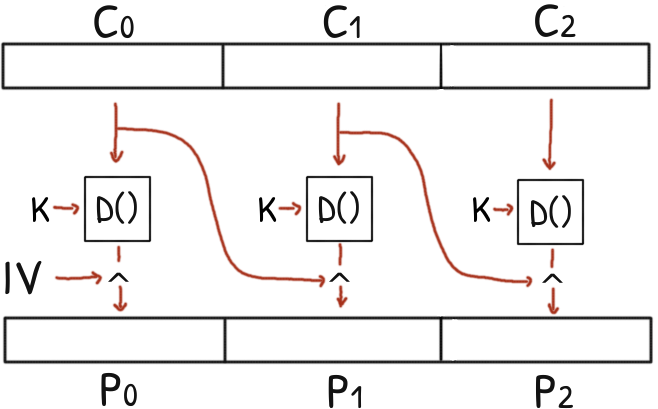ECB/CBC Oracle
June 9, 2018
In this post will review the Cipher Block Chaining mode (or CBC) and how we can build an ECB/CBC detection oracle to distinguish ECB from CBC using cryptonita
– Spoiler Alert! –
This will be the bases for breaking ECB in a later post.
PKCS#7 padding
Implement PKCS#7 padding, easy cake.
>>> from cryptonita import B, load_bytes # byexample: +timeout=10
>>> m = B("YELLOW SUBMARINE")
>>> m.pad(20, 'pkcs#7')
'YELLOW SUBMARINE\x04\x04\x04\x04'
Yeup, PKCS#7 padding validation, I know what is coming with this….
If a plaintext has an incorrect padding, the unpad will fail.
>>> m = B("ICE ICE BABY\x05\x05\x05\x05")
>>> m.unpad('pkcs#7')
Traceback <...>
ValueError: Bad padding 'pkcs#7' with last byte 0x5
CBC - Cipher block chaining
This time we need to Implement CBC mode ourselves, also known as Cipher Block Chaining mode.
At difference with the ECB, the CBC mode uses the previous ciphertext block to XOR the current plaintext block before encrypting it.
For the first plaintext block we use an Initialization Vector for the XOR operation.

This IV should be random but for the sake of the test it will be full of zeros.
>>> import sys
>>> sys.path.append("./posts/matasano/assets")
>>> from challenge import dec_cbc, enc_cbc, enc_ecb
>>> ciphertext = B(open('./posts/matasano/assets/10.txt'), encoding=64)
>>> iv = B(0) * 16
>>> key = B("YELLOW SUBMARINE")
>>> plaintext = dec_cbc(ciphertext, key, iv)
>>> print(plaintext.unpad('pkcs#7'))
b"I'm back and I'm ringin' the bell<...>Play that funky music \n"
At difference with the encryption, the decryption of one block doesn't depend of any other: you can decrypt any block at random or in parallel.

Generating secrets
With the exception of the seed that will be fix to make the test reproducible and the block side to make it a little easier.
Before doing real crypto, we need to generate a secret and random configuration
This configuration will have all the components needed for the challenges: the random key, the IV, the encryption mode and the secret payload.
This secret payload will be appended to the attacker-controlled plaintext so the attacker controls the plaintext only partially.
>>> from challenge import generate_config
>>> seed = 20180610
>>> block_size = 16
>>> secret = B('Um9sbGluJyBpbiBteSA1LjAKV2l0aCBteSByYWctdG9wIGRvd24gc28gbXkg' +
... 'aGFpciBjYW4gYmxvdwpUaGUgZ2lybGllcyBvbiBzdGFuZGJ5IHdhdmluZyBq' +
... 'dXN0IHRvIHNheSBoaQpEaWQgeW91IHN0b3A/IE5vLCBJIGp1c3QgZHJvdmUg' +
... 'YnkK', encoding=64)
>>> cfg = generate_config(random_state=seed, block_size=block_size, posfix=secret)
Now, let’s create the encryption oracle: a function that encrypts a plaintext under a secret encryption mode.
The attacker/adversary will be in control of part of the plaintext to which the secret payload will be appended later before the encryption.
Everything else is secret for the adversary: the key, the IV, the mode.
>>> def encryption_oracle(partial_plaintext):
... global cfg
... cfg = generate_config(cfg) # update the random attributes
...
... block_size = cfg.kargs['block_size'] # (known)
...
... # prepend + append with two random strings; pad it later
... plaintext = cfg.prefix + partial_plaintext + cfg.posfix
... # (unknown) (known) (unknown)
...
... plaintext = plaintext.pad(block_size, cfg.pad_mode)
...
... # encrypt the plaintext with one of the available modes
... # but exactly which, ECB or CBC, is unknown to us
... if cfg.enc_mode == 'ecb':
... ciphertext = enc_ecb(plaintext, cfg.key, block_size)
... elif cfg.enc_mode == 'cbc':
... ciphertext = enc_cbc(plaintext, cfg.key, cfg.iv)
... else:
... raise ValueError("Invalide chain mode %s" % enc_mode)
...
... return ciphertext
On each call, the secret random configuration is regenerated. So everything changes on each call with the exception of the block_size and posfix (secret).
Those two where fixed during the construction of the configuration and they will remain fixed.
The ECB/CBC oracle
Now this is where the action begins.
In this challenge we need to find when a secret encryption is using ECB or CBC mode.
Now, lets create a (partial) plaintext of three times the block size.
With a (partial) plaintext of twice the block size we can know if the cipher is using ECB or CBC because if it is using ECB, two same plaintext blocks will be encrypted to the same ciphertext block
But because we have some extra plaintext prepended, we cannot know if our two blocks will be aligned to the block boundary.
To workaround this we set a plaintext three times the block size:
Now it is a matter of counting duplicated blocks.
In cryptonita there is a convenient iduplicates method for this.
If we found one block duplicated assume that we are using ECB otherwise CBC (so we will use has_duplicates directly).
We will repeat this 1024 to prove that this works:
>>> choosen_partial_plaintext = B('a' * block_size * 3)
>>> for i in range(1024):
... c = encryption_oracle(choosen_partial_plaintext)
... is_ecb = c.nblocks(block_size).has_duplicates(distance=0)
... enc_mode = 'ecb' if is_ecb else 'cbc'
...
... if cfg.enc_mode != enc_mode: # is the same that the secret cfg chose?
... print("Fail")
... break
Break it!
Of course, keep reading.
Related tags: cryptography, matasano, cryptonita, ECB, CBC, oracle PKCS#7

